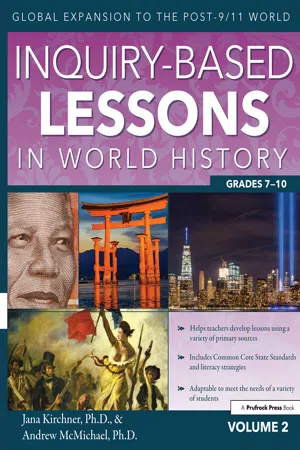
Inquiry-Based Lessons in World History
Global Expansion to the Post-9/11 World (Vol. 2, Grades 7-10)
Jana Kirchner, Andrew McMichael
- 268 Seiten
- English
- ePUB (handyfreundlich)
- Über iOS und Android verfügbar
Inquiry-Based Lessons in World History
Global Expansion to the Post-9/11 World (Vol. 2, Grades 7-10)
Jana Kirchner, Andrew McMichael
Über dieses Buch
Spanning the time period from 750 CE to the present day, Inquiry-Based Lessons in World History (Vol. 2) focuses on creating global connections between people and places using primary sources in standards-based lessons. With sections on the world in transition, the era of revolutions, imperialism and global war, and the modern world, this book provides teachers with inquiry-based, ready-to-use lessons that can be adapted to any classroom and that encourage students to take part in the learning process by reading and thinking like historians. Each section contains chapters that correspond to the scope and sequence of most world history textbooks. Each inquiry lesson begins with an essential question and connections to content and literacy standards, followed by primary source excerpts or links to those sources. Lessons include step-by-step directions, incorporate a variety of literacy strategies, and require students to make a hypothesis using evidence from the texts they have read. Grades 7-10
Häufig gestellte Fragen
Information
PART I
THE WORLD IN TRANSITION
CHAPTER 1
KINGDOMS OF ASIA AND AFRICA
HISTORICAL CONTEXT: WHAT DO I NEED TO KNOW?
STANDARDS ADDRESSED IN THE CHAPTER
- ■ Era 4—Standard 3B: The student understands developments in Japan, Korea, and Southeast Asia in an era of Chinese ascendancy.
- ■ Era 5—Standard 1A: The student understands China's extensive urbanization and commercial expansion between the 10th and 13th centuries.
- ■ Era 5—Standard IB: The student understands developments in Japanese and Southeast Asian civilization.
- ■ Era 5—Standard ID: The student understands how interregional communication and trade led to intensified cultural exchanges among diverse peoples of Eurasia and Africa.
- ■ Era 5—Standard 4A: The student understands the growth of imperial states in West Africa and Ethiopia.
- ■ 6-8: Cite specific textual evidence to support analysis of primary and secondary sources; Determine the central ideas or information of a primary or secondary source; Integrate visual information (e.g., in charts, graphs, photographs, videos, or maps) with other information in print and digital texts; Conduct short research projects to answer a question (including a self-generated question); Draw evidence from informational texts to support analysis, reflection, and research.
- ■ 9-10: Determine the central ideas or information of a primary or secondary source; Cite specific textual evidence to support analysis of primary and secondary sources, attending to such features as the date and origin of the information; Conduct short as well as more sustained research projects to answer a question (including a self-generated question) or solve a problem; Draw evidence from informational texts to support analysis, reflection, and research.

LESSON 1
ORGANIZING QUESTION
STRATEGIES USED
MATERIALS NEEDED
- Handout 1.1: Clue Stations
- The following clues placed around the room in clue stations (Note: Depending on the number of students in your class, you may set up two of each station to allow easier access and keep students on task):
- ✓ Station 1—Atlas: Two versions of Abraham Cresques's Catalan Atlas: the entire atlas picture (available at https://upload.wikimedia.org/wikipedia/commons/3/35/1375_Atlas_Catalan_Abraham_Cresques.webp) and a close image of West Africa and Mansa Musa (available at https://commons.wikimedia.org/wiki/File:Catalan_Atlas_BNF_Sheet_6_Mansa_Musa.webp)
- ✓ Station 2—Travel account: Arab historian Chihab Al-Umari's account of Mansa Musa's visit to Cairo, available at http://www.digitalhistory.uh.edu/active_learning/explorations/1492/mansa_musa_visit.cfm
- ✓ Station 3—Map: Timbuktu: A Center for Trade, available at https://malitradevseuropeantrade.weebly.com/uploads/1/5/2/2/15224772/709840085_orig.webp
- ✓ Station 4—Photographs: The Djinguereber Mosque in Timbuktu and the University of Sankore, available from several websites
- ✓ Station 5—Textbooks, encyclopedias, or computers for student research on Mali and Mansa Musa